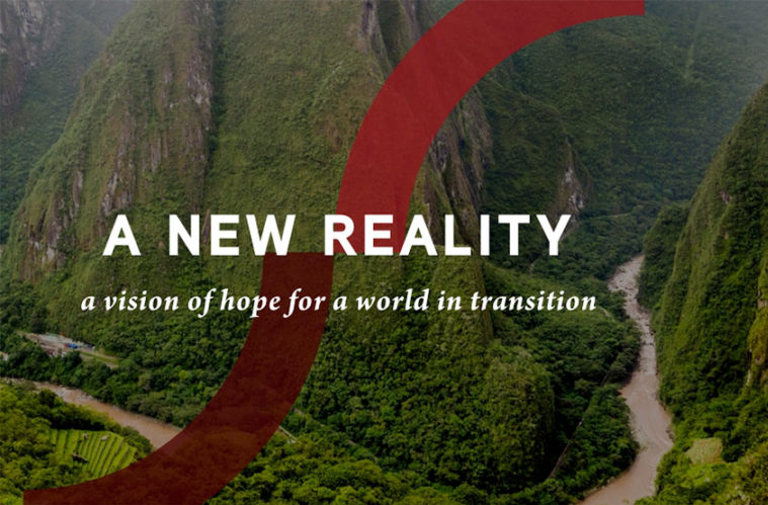On June 26, 2018, A New Reality: Human Evolution for a Sustainable Future was released. Although it certainly looks at a mix of science and culture, this book diverges from many sustainability books. Its ambitions and lessons are both grand and simple, interpreting, understanding, and creating a road map to address the largest human challenges by understanding one thing: the Sigmoid Curve.
Written by Jonas and Jonathan Salk, it was originally released in 1980 as World Population and Human Values: A New Reality. If the name Jonas Salk sounds familiar, it’s because he became a household name when he developed the first effective vaccine to prevent polio. Jonathan, his youngest son, stepped in to help on this project when it was apparent that his father was too busy, only to find he had quite a few ideas of his own. Together, the father and son shaped their thoughts into this book.
“Part of the goal and essence of this book is to offer hope where otherwise things can seem quite bleak,” says Jonathan. “I think my father’s wish, and certainly my wish, is for people to see hope for a world that is in crisis. Hope is contagious and A New Reality provides a context and a way of talking, as well as a way to formulate actions we can take.”
A New Reality revolves around what’s called the Sigmoid Curve which shows population growth in a closed system. The first part of the curve demonstrates a period of unrestrained population growth because of ample natural resources. During this period of time, referred to as Epoch A and dating back to the beginning of human population, people focus on unrestrained growth, competition and power – independence. As resources become scarce, A New Reality uses a pattern seen in nature – decelerating growth in the second part of the Sigmoid Curve – to display a shift that must happen in order for human kind to survive, referred to as Epoch B. In Epoch B, people recognize the limited nature of resources and human values adjust toward equilibrium, balance and consensus – interdependence.
“What we see today across economics, politics, conservation, and more – is the tension between these two value systems. Many people want to go back to the old values, Epoch A values. Others want to go toward the new values, Epoch B values. We must not cling to the past, but move forward to the values of the future.”
Jonathan, a psychiatrist who worked on this re-release in his spare time with the help of David Dewane, explains that the scientific premise that shows the required shift should not be taken as a “given” – in other words, this human shift in values and resulting shift in lifestyles, although the natural bend of the human trajectory, requires individual and collective action to make it happen.
“We must take action to prevent what is possible in nature – which is the collapse of the human population. The transition we need to make is a significant transition not only at the individual level and in the sense of self, but also at societal and international levels. The pressure of population growth and environmental limits make it essential that these changes happen sooner rather than later.”
The book, which is a pictographic essay, tightly combines text and images to explain big ideas and nuance.
“The basic effect of the book should be long-term thinking and greater empathy,” says Jonathan, “rather than seeing the superficial conflicts and disagreeing but not getting anywhere. We’re tremendously adaptable as individuals and as a species, and we’re born with the capacity for Epoch A and Epoch B behaviors. What we’re seeing is a shift in emphasis rather than saying human nature has to change. It is in our nature to be cooperative, as well as competitive.”
Where A New Reality is clear, says Jonathan, is that we must improve people’s lives, especially empowering women, child health and nutrition as well as sustainable development.
“We were in a different reality – free of resource restrictions or population pressures,” says Jonathan when he’s talking about Epoch A. “Now we’re just past the inflection point and entering at time of limits, and there’s relief in seeing current conflicts in this broader perspective. It helps explain what actions to take and how those actions have a huge impact on the future. We’re all looking to see what we can do.”
ABOUT A NEW REALITY:
A New Reality: Human Evolution for a Sustainable Future by Jonas Salk and Jonathan Salk with David Dewane provides a scientific basis for recognizing that the current confusion and cultural conflict humanity is experiencing is neither predetermined nor our destiny but is, instead, part of a natural evolutionary process. The book shows us that a fact-based understanding of present conditions can lead us to a new reality reflecting interdependency, collaboration, and concern for the well-being of the many. It was published by City Point Press on June 26, 2018. Visit www.anewrealitybook.com.





